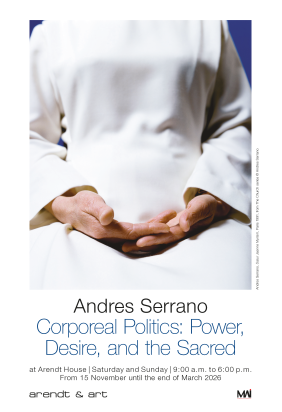
Andres Serrano – Corporeal Politics: Power, Desire, and the Sacred
About the exhibition
Since the 1980s, Andres Serrano has built a provocative and striking body of photographic work that moves between the sacred and the unspeakable. This exhibition brings together emblematic moments from the Immersions, The Morgue, Objects of Desire, America, and Holy Works, where spirituality, corporeality, beauty, and social realities intertwine.
Born in 1950 in New York to a Spanish-speaking Catholic family, Serrano developed a practice deeply rooted in religious iconography and the Western pictorial tradition, particularly the Baroque. Yet far from simply reproducing visual tropes, he transposes them into the present: crucifixes submerged in bodily fluids, anonymous corpses lit with the solemnity of Old Master painting, explicit tableaux of sexuality, portraits of America in all its contradictions, and contemporary re-imaginings of biblical figures. Across these series, Serrano continually returns to the same tensions: between the sacred and the profane, purity and impurity, beauty, and abjection.
As Susan Sontag has argued in Regarding the Pain of Others, photographs of death and violence place the viewer in confrontation with the very threshold of visibility, testing the limits of what can be endured and of what society deems admissible to be seen. Such images inevitably oscillate between voyeurism and empathy, between the spectacle of suffering and the ethical obligation to acknowledge its reality. Serrano’s photographs through different series enacts this oscillation. Serrano refuses the neutral objectivity of documentary photography by reconfiguring the body through a painterly attention to framing, chromatic intensity, and the modulation of light, thereby transposing it into the aesthetic and affective realm of art history.
Likewise, his portraits recall Michel Foucault’s notion of the body as a site where power and ideology are inscribed. For Foucault, modern societies discipline and regulate bodies, turning them into visible carriers of status, exclusion, or privilege. By placing politicians, celebrities, workers, homeless individuals, and members of the Ku Klux Klan within the same aesthetic frame, Serrano equalizes their representation while simultaneously revealing the marks of power that differentiate them. The result is a stark meditation and confrontation on visibility, hierarchy, and the contradictions of American identity.
Rejecting hierarchies, Serrano blurs boundaries to expose what society would prefer to hide – the presence of death in life, of the divine within the carnal, of desire within prohibition. His images-tightly framed, chromatically intense, and meticulously composed – echo the painter’s canvas, asserting photography as both artifice and revelation.
At the heart of this work lies a fundamental ambiguity: the body as both vessel of transcendence and site of scandal; America as puritanical yet violent, devout yet consumerist; photography as both documentary truth and metaphysical allegory. By exposing fears, taboos, and desires, Serrano compels the viewer into an experience that is at once unsettling and profoundly reflective.
His works are held in major public and private collections, including the Museum of Modern Art, the Whitney Museum of American Art, the New Museum of Contemporary Art in New York, the Rijksmuseum, the Pinault collection and the Maison Européenne de la Photographie in Paris. Serrano is represented by Galerie Nathalie Obadia (Paris/Brussels).
(Claire & Paul di Felice, curators)